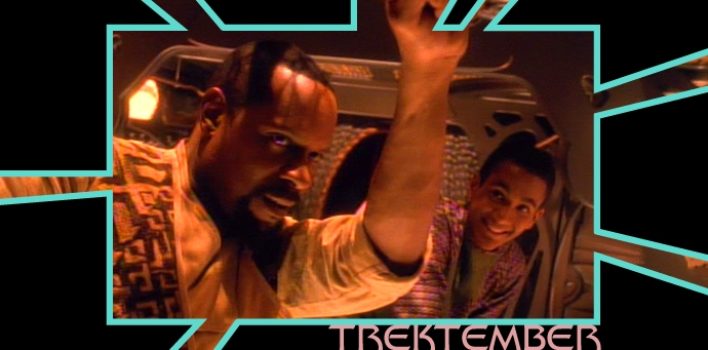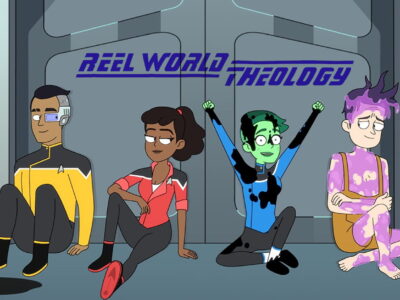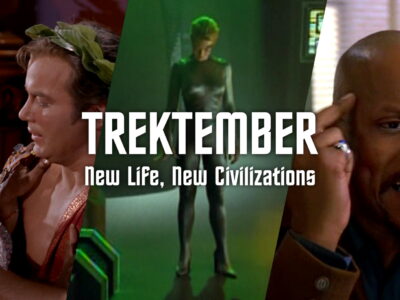Trektember: Explorers
In the Trektember Season 4 preview, I mentioned that “Explorers” is the first episode of any Star Trek that I remember watching live as it aired; and I also said that I felt like the climax of the episode’s character arcs was Deep Space Nine in a nutshell.
But I also think it goes further than that. “Explorers” isn’t the best episode of Star Trek (it isn’t even the best episode of Deep Space Nine), but I think it definitely provides an example of Star Trek at its most basic; its platonic ideal, its clearest thesis. Put simply, I think this is one of the most Star Trek-y episodes of Deep Space Nine; featuring exploration with a deeper purpose, a serious duty to the truth; and beneath it all, mapping abstract issues onto fantastical external problems.
Interpersonal Exploration
That may be the most important thing to understand about humans: it is the unknown that defines our existence. We are constantly searching, not just for answers to our questions, but for new questions. We are explorers. We explore our lives, day by day; and we explore the galaxy trying to expand the boundaries of our knowledge.
—Ben Sisko, “Emissary”
From the beginning of Deep Space Nine, the exploration of character has been at the forefront. But that’s not to say that characters just sit around thinking while staring into the middle distance, or spend hours pontificating about the meaning of life with others (not usually, at least). No, the series—in the greatest tradition of Trek—builds those thoughts and ruminations into a science fiction premise, allowing the characters to deal with problems and concerns in a very literal, physical, concrete way.
In “Explorers,” Jake is exploring the idea of life as an adult apart from his dad. Ben, in the same vein, is dealing with the reality of an adult son who could soon be leaving him, both in the sense of leaving the station and in the fact that he’s not going to follow in his dad’s footsteps. At their core, though, they’re both afraid of being alone; albeit in different ways.
Then, as we’re discovering their complex emotions, they’re suddenly lost and alone in the vastness of empty space, unarmed, unequipped, completely unable to figure out what to do next, light-years from anyone who can help. Their internal conflict has become external; they are alone.
This is something all good sci-fi does: our problems, fears, conflict, and feelings seem more solveable when we face them in physical form on the screen. Sci-fi and fantasy simply give us the opportunity to do that in a literal way, facing literal aspects of our psyche or personifications of abstract fears. So we can tackle them with experience. And this shouldn’t be unfamiliar to the Christian, because God does the same thing in the Bible.
The miracles God performs are His way of making His values clear in a concrete and real way. The prophets He sends are a way of calling His people to repentance, but they’re also a physical proof of His love for them. His laws represent His goodness, holiness, and plan in an earthly form. We can explore who He is through the ways He interacts with His people.
And when He wrote Himself into the story as Jesus, He became all of those things at once. Jesus was not merely a man, but also God; and as such, He was truth incarnate.
But how can we understand that truth?
Intimate Truth
When the ancient Bajorans reached for the skies, launching primitive vessels into space, it was more than just an exploration. It was more than just a trip to plant a Dahkur Province flag on the moon.
They were reaching for the truth.
For many thousands of years, the Bajoran people had heard from their gods, spectacular, powerful beings known as the Prophets. The Bajoran people had heard from them in the form of mysterious energy structures called “Orbs,” but they had never met the Prophets directly; never spoken to them or seen the “Celestial Temple” in which they resided. And so the first trip of a Solar Sailor into the depths of space wasn’t merely a scientific excursion; it was a pilgrimage.
They sought that truth for much the same reason that we seek to understand Jesus. To know God is to know what He is all about; to know why He created us and what He wants for us. It makes Him more concrete and real when we can know Him.
But the big difference between the Bajoran and the Christian is that we don’t need to invent a miraculous solar sail to meet Jesus. We don’t need to venture into space on a celestial pilgrimage. In fact, we don’t need to go anywhere.
Instead, He came to us!
We can understand Him through the words He sent; the Bible he gave us is, like the Orbs, a way for Him to communicate with us. But because He came to Earth and died on the cross, He gave us the ability to meet and understand Him directly. He let us meet Him, to experience His truth directly. He made a way for us to be with Him for all eternity.
That way, when we travel out into the universe, we’re not looking for answers, for truth, for evidence or proof. When we travel out into the unknown, whether that unknown is deep space or just “Tuesday,” we can do so with the knowledge and confidence that we have the Truth, and that the Truth Himself goes with us.
Because He is the Explorer who found us.







